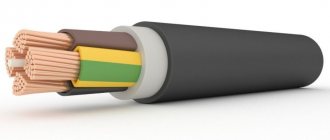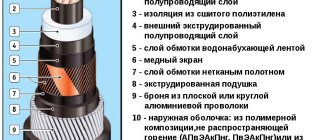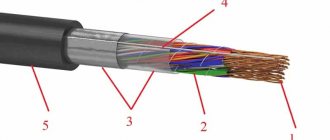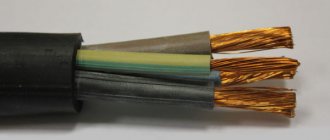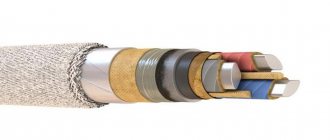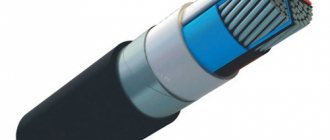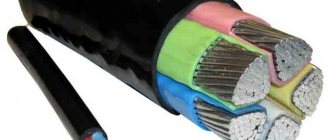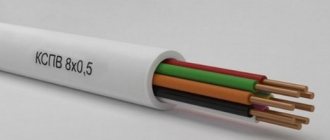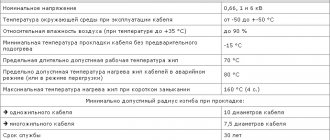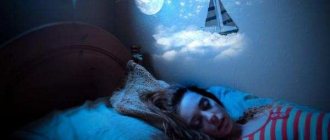The MKESh type cable is designed for transmitting control signals or communication signals, mainly analog. Belongs to the category of installation cables, that is, those that connect various electrical and/or electronic modules within one system, connecting them into one whole.
Its range of use includes various telemetry and telephone systems, instrumentation and automation equipment and other areas with similar tasks. Unlike the Ethernet cable (twisted pair category 5), which is popular in modern communication networks, the MKESh cable can withstand a fairly high voltage - up to 500 V AC. There is a special version of this wire adapted for digital signal transmission.
How is it deciphered?
The wire is marked not only with letter values, but also with numbers. You can decipher MKESH as:
- M - the cable belongs to the installation group;
- K is a subtype of conductor. This means that the insulation contains a nylon layer;
- E - the wire is shielded;
- Ш - external insulation is made of polyvinyl chloride.
What the product looks like.
The cable can also be found under the name MKSh. This indicates that the product does not have a shielded sheath, due to which the price of the wire will be lower. There are varieties of the product MKEShv, MKEShVng, MKEShVng-LS, you can read about them in more detail on the Internet. Below is a detailed description of the technical parameters.
Wire MKESh technical characteristics and design
Explanation of the name
According to the old Russian tradition, each letter in the abbreviation name is part of the index and carries a certain semantic load. So, in this case the name means:
- M - mounting;
- K - cable (not wire);
- E - shielded;
- Sh - silk.
Silk in this case means an additional shell that separates the conductors in individual shells from the screen. It is made of synthetic polyamide silk
The alphabetic code is traditionally supplemented by a digital code, format (for example) 4 × 0.75. Here the first number is the number of cores in the cable, and the second is their cross-section.
There are other varieties of this product, for example, the MKESHVng cable is non-flammable (meaning, it does not support combustion when laid in a bundle), or its more “advanced” variety - the MKESHVng ls cable - is also non-flammable, but at the same time does not emit harmful substances. health of substances during melting. There is a variation of the MKSh - everything is the same, but without a protective screen (“budget” version).
Technical specifications
Main product parameters:
- The use of the wire is permitted at constant and alternating mains voltage. The optimal alternating voltage is 0.5 kV at a frequency of no more than 400 hertz;
- operating temperature ranges from −50 to 70 degrees. The gasket temperature should not be lower than −15. Otherwise, the insulating layer may be damaged;
- the critical temperature at which the wire can function is 130 degrees;
- the bend radius is equal to four diameters;
- humidity indoors or outdoors should not be higher than 95%;
- the wire is allowed to be laid together with other types of products in one bundle;
Cable MKESH 7×0.35
- the construction length of the wire is 30 meters and above;
- MKESH - cable resistant to mechanical loads;
- The service life of the wire is 15 years;
- minimum 2 year warranty.
All parameters can be found in the product specification that comes with the purchase of the cable.
Selection by table
Knowing the diameter of the wire, you can determine its cross-section using a ready-made dependence table. The table for calculating the cable cross-section by core diameter looks like this:
| Conductor diameter, mm | Conductor cross-section, mm2 |
| 0.8 | 0.5 |
| 1 | 0.75 |
| 1.1 | 1 |
| 1.2 | 1.2 |
| 1.4 | 1.5 |
| 1.6 | 2 |
| 1.8 | 2.5 |
| 2 | 3 |
| 2.3 | 4 |
| 2.5 | 5 |
| 2.8 | 6 |
| 3.2 | 8 |
| 3.6 | 10 |
| 4.5 | 16 |
When the cross-section is known, it is possible to determine the permissible power and current values for copper or aluminum wire. In this way, it will be possible to find out what load parameters the current-carrying core is designed for. To do this, you will need a table of the dependence of the cross section on the maximum current and power.
| In the air (trays, boxes, voids, channels) | Section, sq. mm | In the ground | |||||||||
| Copper conductors | Aluminum conductors | Copper conductors | Aluminum conductors | ||||||||
| Current. A | power, kWt | Tone. A | power, kWt | Current, A | power, kWt | Current. A | Power, kWt | ||||
| 220 (V) | 380(V) | 220(V) | 380(V) | 220(V) | 380(V) | 220(V) | |||||
| 19 | 4.1 | 17.5 | 1,5 | 77 | 5.9 | 17.7 | |||||
| 35 | 5.5 | 16.4 | 19 | 4.1 | 17.5 | 7,5 | 38 | 8.3 | 75 | 79 | 6.3 |
| 35 | 7.7 | 73 | 77 | 5.9 | 17.7 | 4 | 49 | 10.7 | 33.S | 38 | 8.4 |
| *2 | 9.7 | 77.6 | 37 | 7 | 71 | 6 | 60 | 13.3 | 39.5 | 46 | 10.1 |
| 55 | 17.1 | 36.7 | 47 | 9.7 | 77.6 | 10 | 90 | 19.8 | S9.7 | 70 | 15.4 |
| 75 | 16.5 | 49.3 | 60 | 13.7 | 39.5 | 16 | 115 | 753 | 75.7 | 90 | 19,8 |
| 95 | 70,9 | 67.5 | 75 | 16.5 | 49.3 | 75 | 150 | 33 | 98.7 | 115 | 75.3 |
| 170 | 76.4 | 78.9 | 90 | 19.8 | 59.7 | 35 | 180 | 39.6 | 118.5 | 140 | 30.8 |
| 145 | 31.9 | 95.4 | 110 | 74.7 | 77.4 | 50 | 775 | 493 | 148 | 175 | 38.5 |
| ISO | 39.6 | 118.4 | 140 | 30.8 | 97.1 | 70 | 775 | 60.5 | 181 | 710 | 46.7 |
| 770 | 48.4 | 144.8 | 170 | 37.4 | 111.9 | 95 | 310 | 77.6 | 717.7 | 755 | 56.1 |
| 760 | 57,7 | 171.1 | 700 | 44 | 131,6 | 170 | 385 | 84.7 | 753.4 | 795 | 6S |
| 305 | 67.1 | 700.7 | 735 | 51.7 | 154.6 | 150 | 435 | 95.7 | 786.3 | 335 | 73.7 |
| 350 | 77 | 730.3 | 770 | 59.4 | 177.7 | 185 | 500 | 110 | 379 | 385 | 84.7 |
Converting watts to kilowatts
In order to correctly use the table of wire cross-section versus power, it is important to correctly convert watts to kilowatts. 1 kilowatt = 1000 watts
Accordingly, to obtain the value in kilowatts, the power in watts must be divided by 1000. For example, 4300 W = 4.3 kW
1 kilowatt = 1000 watts. Accordingly, to obtain the value in kilowatts, the power in watts must be divided by 1000. For example, 4300 W = 4.3 kW.
Wire design
MKESH consists of stranded copper wire. The number of cores can vary from four to fifteen. The veins are twisted together. The outer insulation layer is made of polyvinyl chloride. It is flame resistant. A special synthetic shell is placed on the top of the core, and a protective screen is placed on it.
You may be interested in Description of terminals for wires
Note! The shielded layer consists of small copper wires, which have a density coefficient of 62%. The main purpose of the screen is to protect the product from a variety of electromagnetic noise.
Shielded conductors
Thanks to the shielded layer, the wire functions stably and conducts electric current correctly. Below we describe where MKES is most often used and how to choose it correctly.
Supporting notes
The cables through which telephone communications are carried out consist of individual insulated conductors, called cores, twisted in pairs or quadruples and enclosed in a common sealed sheath of metal, plastic or metal-plastic. On top of this moisture-proof sheath, the cables, depending on the installation method, may have protective armor coverings.
The conductors that make up a telephone cable are called conductors, made of copper and aluminum. These materials have good electrical conductivity, flexibility and sufficient mechanical strength.
To insulate telephone cable cores, they use special telephone paper 0.05 mm thick, polyethylene, which has sufficient strength and low moisture absorption, and polystyrene (styroflex), which has good insulating properties and is used for high-frequency cable cores.
A sealed sheath is placed on top of the belt insulation on the cable core, which protects the cable from moisture penetration into it, as well as from various influences (electrical, chemical, mechanical). The industry produces cables with metal, plastic and combined metal-plastic sheaths.
To protect telephone cables laid directly in the ground from mechanical damage and the action of organic acids, alkalis and stray currents that cause corrosion, special protective covers are applied to the metal or plastic sheath.
Each cable, according to GOST, has a symbol or brand consisting of letters and numbers.
1. How are communication cables divided by purpose and design?
2. Explain the resistivity of copper and aluminum wire.
3. What do you know about paper insulation?
4. What do you know about the pair and star twist?
5. Tell us about the twisted cable core.
6. What do you know about the protective aluminum shell?
7. Why is a special protective cover applied to the cables?
8. What do the letters on the cable markings mean?
9. What do the numbers on the cable marking mean?
10. What do you know about type B and type K armor?
1. According to their purpose, communication cables are divided into intercity, zone, urban and rural. Coaxial cables represent a separate group. By design, communication cables can be symmetrical or coaxial.
2. The resistivity of a copper conductor at a temperature of 20 °C is 0.0175 Ohm Chmm 2 ∕m, an aluminum conductor at the same temperature is 0.295 Ohm Chmm 2 ∕m. This shows that the resistivity of an aluminum conductor is 1.65 times greater than that of a copper conductor.
3. With air-paper insulation, the cores are wrapped in a spiral with paper tape. The tape is applied to the core so that the inner diameter of the tube is slightly larger than the diameter of the core. Thus, gaps are formed between the core and paper tube, filled with dry air, which is a good insulator. A type of air-paper insulation is paper pulp, covering the cable cores with a continuous layer of paper pulp.
1. What types of cables are there by frequency range?
A) high frequency and low frequency
B) only high-frequency
B) only low-frequency
2. How many times is the resistivity of an aluminum conductor greater than that of a copper conductor?
A) 1.55 times
B) 1.65 times
B) 1.75 times
3. What is the thickness of the special telephone paper used to insulate telephone cable cores? 0.05 mm
Scope of application
MKESh cable is mainly used in such industries as:
- video surveillance and alarm;
- electronic systems switching units;
- in measuring instruments;
- in telephony;
- for connecting a variety of sensors.
In terms of use, MKESh cable is one of the most popular and is widely used in various fields. It is used to make permanent connections of electrical equipment in both domestic and industrial premises. Due to its design, this wire cannot always be used. The limitation is the AC current limits.
External laying process
How to choose the right one
Like any cable product, MKESh must first be assessed visually. The packaging must be intact, the outer hose itself must be free of cracks and minor damage. It is recommended to ask the seller for a certificate for the product, which indicates the manufacturer, the warranty period for the cable and the date of manufacture.
When choosing, you must rely on the power of the devices that will be connected to the cable. Also, the power of the devices determines which wire cross-section to choose. The larger the cross-section, the higher the resistance in the network will be.
The main advantages of the MKESH universal installation cable
The demand for this type of cable products has good reason. Among engineers and designers of electrical networks, MKESh wires are valued for:
- Resistance to external electromagnetic interference.
- High mechanical strength indicators.
- Ensuring data protection, including from unauthorized access.
- Fire safety, since the ng(A) cable does not support combustion.
- Ability to withstand significant temperature changes.
- Long service life.
The above qualities guarantee that the power grid will operate stably and reliably, performing its tasks 100% and without requiring expensive maintenance.
How to connect
The main advantage when laying the MKESh cable will be the ability to place it in cable ducts, pipes, trenches and other places with models for other purposes.
Cable shielding in the diagram
Cable shielding in the diagram The shielding layer does not allow electromagnetic interference from other wires to penetrate the conductors of the MKESH. This facilitates reliable transmission of control impulses, without noise, over long distances.
But to guarantee correct data transmission, it is necessary to correctly install the MKESH wire. Sometimes in distribution panels the ends of the cable cores were separated into cross-connect contacts.
Currently, a large number of crossover blocks are being made, where reliable fixation and electrical contact occur.
Consequence of short circuit
Consequence of a short circuit Through each end of the wire, a signal is transmitted to one or another device, so you need to connect everything according to the diagram. Otherwise, the equipment will not only fail, but also cause a short circuit. Connection rules:
- A plastic funnel is placed over the outer insulation of the wire, secured with a clamp, and all the wires are removed. The product is placed in a vertical position and epoxy resin must be placed in this funnel. After the wire dries, you can begin to solder it into cross-connects;
- if the ambient temperature is below −15, then the installation is not carried out, or the cable is preheated in the room;
- The wire can be laid under the soil in metal, asbestos or plastic corrugations, through the air or in the wall of a room.
You might be interested in Cable and wire insulation
Quality Control Methods
You can check the quality of the purchased MKESH cable without resorting to the services of a specialized laboratory. However, it should be remembered that the data obtained are not considered an expert opinion and are preliminary in nature.
When receiving a batch, it is recommended to use the following methods:
- Visual inspection
The purpose of which is to check the number of cores, as well as the number of wires in the core, the presence of a shielded layer (braiding) and the integrity of the protective insulating coating.
- Measuring structural dimensions
This is carried out using measuring instruments with appropriate divisions. Allows you to check the compliance of the insulation thickness, sheath and outer diameter as declared by the manufacturer. Calculation of the core cross-section using the formula 0.785dpr2 * N (where N is the number of wires in the core) is not a strict control method, but can only serve as an indirect basis for a more thorough double-check.
- Electrical resistance measurement
This is done using an ohmmeter. The key to correct data is good contact between the cable and the test leads. Compliance with these simple recommendations and cooperation with trusted suppliers will ensure the proper quality of electrical connections and minimize the risk of power outages caused by the cable.
Common mistakes
Three main mistakes when laying cables:
- they forget about the number of veins. First of all, it is advisable to decide how many cores are needed to control network objects. Basically, a common cable and or screen with grounding is inserted onto each element. If, for example, there will be control with four objects, then five wires are needed
- Sometimes people don't know how to calculate cross-sectional area. For systems with low voltage, a cross section of up to 0.35 - 05 mm2 is suitable. For systems with 220 and above, 0.75 mm square is used;
- When laying, the shielding layer of the cable is not grounded and waterproofing is done at the ends.
Product marking
Explanation of the TPPep marking
To determine the main parameters of the TPPep cable, consider its markings. The marking includes alphabetic and numerical designations indicating the scope of application and other characteristics, namely:
- T - indicates that this is a telephone cable designed to transmit communication signals;
- P – cable cores are insulated with polyethylene;
- P – denotes the material of the outer shell of the insulating layer – polyethylene;
- ep - indicates the presence of a film-type screen; in cases where this letter designation is absent, the cable is equipped with a foil screen, but such models are no longer produced, but are in use.
In addition to the above standard markings for TPPep, additional ones can be used. For example, if there is the letter “Z” - TPPepZ, such marking will mean that it has a hydrophobic filling, oil or other based on fatty compounds, which prevents the accumulation of moisture. The letter “B” - TPPepB indicates the presence of armor around the main cable sheath, usually made of tin tape. The presence of the letter “M” in front of the TPP - MTPP indicates that the model has few pairs - the number of pairs in it is from 1 to 5, and the prefix “ep” may also be absent - then the wire does not contain a screen.
Consider an example of decoding the cable marking TPPepZB - 100 × 2 × 0.64. Accordingly, here is a telephone cable with polyethylene core insulation and polyethylene sheath insulation, a film screen, filled with a hydrophobic substance with an armor coating. 100×2 - indicates that the cable uses 100 working pairs, but in practice there are slightly more of them - 102, 103 or 105, the rest are used as spare ones. Spare conductors are included in models of 50 pairs or more. 0.64 is the diameter of the conductor, in this case it is 0.64 mm.
Transportation and storage rules
Like all cable products, MKESh must be stored in a dry and moderately humid room. At humidity levels above 90%, mold and mildew may form on the product, which will damage the insulating layer over time. All coils of wire must be stored on special cable drums (reels). There should be no rodents in the warehouse, as they can easily bite through the PVC shell. Storage under a canopy in the open air is allowed, but not more than 1000 hours in total and without direct sunlight.
Storage in reels
It is necessary to transport cable reels only in a special truck, having previously secured them. Loading and unloading is done using a small crane.
Note! Pulling out the coils with your own hands is dangerous.
If errors were made during storage, this will significantly shorten the life of the product.
Manufacturers
Currently, there are many factories producing cable products. To avoid falling for a fake, it is recommended to choose the most proven ones. If a person is at a loss as to which factory to give preference to, you can visit the forum of electricians, who will tell you exactly which companies are more in demand. Below are a number of the best manufacturers.
How to transport it correctly
JSC "Belaruskabel"
The plant was founded in the Republic of Belarus back in the late 50s of the last century. We stock thermal radiation wires, heat resistant wires, RF wires, and many others. They deliver to Europe and Russia. They cooperate with well-known companies. There are always more than 30,000 types of products in stock. Delivery by air or rail to the most remote points of the country. The maximum product warranty is 5 years.
You may be interested in Description of wire clamps
LLC "TD "Belkab"
The company was founded relatively recently, in 2009. During this time, they became one of the largest factories in Belarus and opened several branches in Russia. The manufacturer has all subtypes of MKESH cables in stock. The only drawback is that the company does not yet have its own website with an assortment. Therefore, to find out about product availability, you have to call or email.
JSC "Cable
One of the first cable companies that delivers throughout the country from any order amount. They work with well-known industrial and shipping companies. The company has many positive reviews and awards for its impeccable work. There are more than 35,000 thousand macro connectors products in stock.
Production process
KazElectroMash LLP
The plant was founded in the city of Semipalatinsk in the 1990s. Over the years of operation, the enterprise has laid more than one hundred kilometers of cable lines. There are more than 20,000 thousand types of macro connectors. A research center was built on the territory of the enterprise, so all products are of high quality. Individual approach to each order, even small ones. One of the fastest delivery of products to the client.
In conclusion, it should be noted that MKESh wire is excellent for telephone and security systems, CCTV cameras. More and more offices are switching to this cable model. When purchasing, it is advisable to read reviews about each factory or seek help from an experienced electrician.
